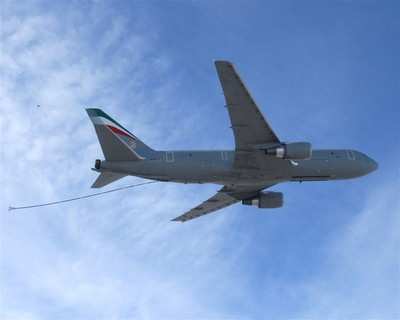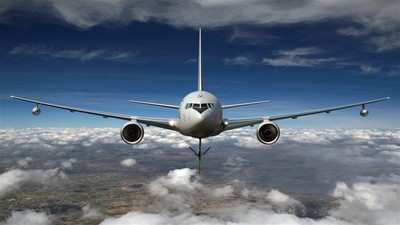Program Reaches New Milestone With Hose Extension
 Boeing officially announced Tuesday
it will offer the KC-767 Advanced Tanker for the US Air Force's
KC-X Tanker competition.
Boeing officially announced Tuesday
it will offer the KC-767 Advanced Tanker for the US Air Force's
KC-X Tanker competition.
"The Air Force has made it clear -- the mission is refueling
aircraft, often in tight, hostile locations. The Boeing KC-767
Advanced Tanker is made for this mission," said Ron Marcotte, vice
president and general manager of Boeing Global Mobility Systems.
"It is the ideal fit for the requirements set forth in the Air
Force's Request for Proposals. Highly energy efficient, agile and
with exceptional takeoff performance, the KC-767 puts more fuel
closer to the fight -- with access to more than 1,000 additional
bases worldwide than the KC-135."
The tanker will be an advanced derivative of the future 767-200
Long Range Freighter and will be produced at Boeing's facilities in
Everett, WA, where it's already produced more than 950 767s. The
company will install military refueling systems and conduct flight
test activities at its finishing center in Wichita, KS.
The Chicago-based planemaker made several tweaks to the design
of its upcoming 767 freighter to better suit its new role as a
tanker. The Seattle Times reports those changes include
modifications to increase fuel efficiency, as well as changes to
improve the 767's short-field performance.
In related news, the KC-767 reached another major milestone
Saturday when its aircrew successfully extended and retracted the
refueling hose from the centerline hose drum unit (HDU) during a
test flight over Kansas.

Over the next several months, Boeing will conduct some two dozen
flights at various speeds and altitudes while trailing the hose to
ensure the system's stability. At the end of the hose is a
backward-facing funnel-shaped basket -- or drogue -- which mates
with the refueling probe installed on some jet aircraft.
"Obviously we see trailing the Hose Drum Unit as a significant
step forward since most of our country's military aircraft utilize
this system when refueling," said Lieutenant Colonel Roberto Poni,
Italian Air Force Tanker program liaison.
The USAF primarily uses a boom for aerial refueling, but the
Italian Air Force, along with the US Navy, US Marine Corps and
other NATO countries predominantly use probe and drogue
refueling.
The KC-135 has probe and drogue capability, but the hose and
drogue must be installed on the ground. In its RFP, the USAF stated
a need for both boom and probe and drogue refueling capability for
the KC-X.
When fully functional, the HDU has the capability to refuel
large or small probe-equipped aircraft with an offload rate of 600
gallons of fuel per minute.
The KC-767 also is configured to carry two Wing Aerial Refueling
Pods (WARPs) for probe and drogue refueling missions, allowing
the simultaneous refueling of multiple aircraft. The WARPs can
offload 400 gallons of fuel per minute.

Boeing has partnered with Smiths Aerospace, Rockwell Collins,
Vought Aircraft Industries, Honeywell and the newest member --
Spirit AeroSystems in building the KC-767. The team has proven
expertise in aerial refueling systems, network centric operations,
integrated avionics solutions and lean manufacturing concepts.
"This KC-767 Advanced Tanker will support more than 44,000
American jobs and 300 suppliers," said Mark McGraw, vice president,
Boeing Tanker Programs.
Boeing says it has already invested more than $1 billion in the
KC-767. Aside from the wing refueling pods and the HDU, the company
says it sports a fly-by-wire boom, the most advanced 777 commercial
digital flight deck and a third-generation remote vision refueling
system.
Boeing is building four KC-767 tankers each for Italy and Japan.
Both countries are slated to get their first tanker this year.
 Lockheed Hands Over Completed Artemis II Spacecraft
Lockheed Hands Over Completed Artemis II Spacecraft NTSB Final Report: Pulsar Super Pulsar
NTSB Final Report: Pulsar Super Pulsar Classic Aero-TV: Van Horn Rotor Blades -- Tail Rotor Replacements For Bell's 206
Classic Aero-TV: Van Horn Rotor Blades -- Tail Rotor Replacements For Bell's 206 ANN's Daily Aero-Term (05.02.25): Obstacle
ANN's Daily Aero-Term (05.02.25): Obstacle Aero-News: Quote of the Day (05.02.25)
Aero-News: Quote of the Day (05.02.25)





